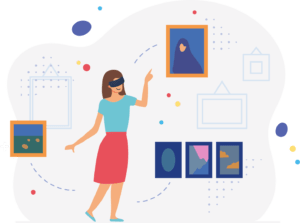RITS can help you design rich experiences or assist with ideas for experiential learning activities and projects with your students.

There are some approaches and scenarios that you can use to support your pedagogy.
Scenario #1
Producing and sharing 360 ethnographic video
Using cameras such as GoPro, Insta360. Editing workshops via RITS. The study of immersive video use for ethnographic studies. RITS assists with camera loan, workshops and background on effective use of 360 video production. Helps with task and activity design.
Scenario #2
The use of Google Cardboard handheld viewers for use with mobile phones. Utilizing RITS Oculus Quest headsets, or HTC Vive stand alone technology. RITS can assist with workshops, pedagogy, background research and implementation. Locate: places for students to visit virtually to take notes, collaborate, help with project background, discussion points. Helps with task and activity design.
Scenario #3
Using digital mapping to research and collaborate in Shanghai or other locations. Use of tools such as Google Maps, ESRI Story Maps, ArcGIS Online to produce and edit maps on computers or via physical mapping tasks in the community (can be done individually by students in Shanghai or via tailored tasks in their own location – i.e. mapping and documenting historical sites; gathering stats data on waypoints or other physical location through observation, data gathering and later plotting on maps. RITS can assist with running physical or remote workshops in how to use the tools effectively. Helps with task and activity design.
Scenario #4
Faculty sets up specialized software or simulations on a dedicated virtual computing lab (VCL). Students utilize software or computation for specialized projects. Example: utilising higher performance physical or virtual computers to complete animation or video rendering. RITS assists with liaison to IT services. Runs workshops. Helps with task and activity design.